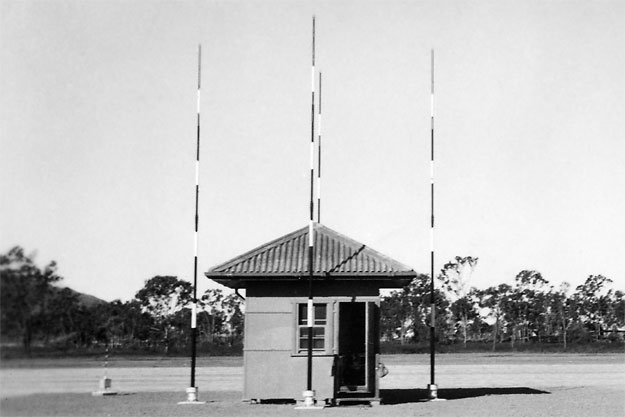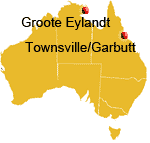Adcock-type
High Frequency Cathode Ray Direction Finding equipment (HF CR DF) was
installed at selected locations around Australia from 1939 to replace
the earlier MF Bellini-Tosi equipment.
At this time direction-finding equipment was an important aid to navigation
due to the scarcity of radio beacons.
The MF-DF equipment suffered badly from atmospheric interference, and coastal and night effects caused by radio signal propagation changes. Operating at a higher (2-12 MHz) frequency, the vertically polarized Adcock system gave steady bearings under all conditions of changing polarization and could be used 24 hours a day. The relative freedom from static and visual presentation of the signal on a cathode ray screen could make possible an aircraft bearing which would have been lost in static on the aural MF-DF system. HF-DF equipment was installed at Darwin, Karumba, Liverpool (NSW), Lord Howe Is, Archerfield, Cloncurry, Cooktown, Rockhampton, Townsville, Port Moresby, Salamaua and Groote Eylandt (seen here).
Early DCA Aeradio operator Rod Torrington remembers: "The Groote Eylandt equipment was trans-shipped at Thursday Is. to the Leisha (operated by Captain Ruska and his son of Burketown, Qld.) and brought to Groote in July 1940. The equipment was installed by a PMG Installation Party with Vern F. Kenna as Engineer-in-charge. The installation party arrived at Groote on 29 July 1940 by RAAF Flying Boat (an ex-Qantas "C" Class flying boat taken over by the RAAF) piloted by Capt. Hemsworth and F/O J Len Gray, both of whom were ex-Qantas flying boat crew. The equipment was installed at Groote in August 1940."
The HF CR DF equipment was manufactured by Amagamated Wireless (Australasia) Ltd. (AWA), Sydney, in 1939-40. The photo above shows the receiver hut at Groote Eylandt in shortly after completion in 1940. Note the four vertically-polarised 20' antennae which enabled the direction of a received signal to be determined. A small test antenna, which could be used to check the calibration of the system, was located within the fenced compound.
To ensure there was no radiation from wires or cables in the vicinity of the DF, all cables (a/c supply, telephone lines, etc) had to go underground to the receiver hut. The cables were buried 6 feet deep for 300 feet from the hut.
Click here to see photos of the operator's console.
The photo
below shows the Adcock installation at Townsville's Garbutt aerodrome
during the 1940s. Note the extensively cleared area surrounding the antennas.
Garbutt had been established in the late 1930s as a civil aerodrome, but
the RAAF quickly established a presence there. During the Second World
War, particularly from late 1941 onward, RAAF Garbutt became a major logistical
hub in support of the war in the Pacific. Good navigational facilities
were therefore essential.

(Photos: Top and Middle-CAHS/Rod Torrington collection / Bottom-CAHS collection)
Back to
the Communications
& Navigation index page
If this page appears without menu bars at top or left, click here
